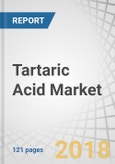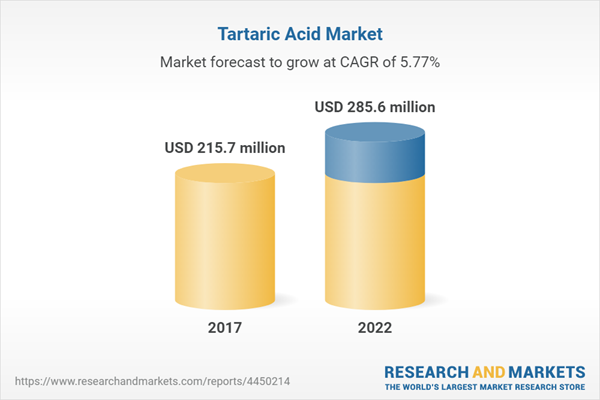Tartaric acid market is projected to grow at a CAGR of 5.77%, in terms of value
Grapes & sun-dried raisins segment is projected to be the fastest-growing in the tartaric acid market
Grapes are largely used for wine making; growth in the wine industry in terms of consumption is attributed to the larger market share of grapes & sun-dried raisins as the concentration of tartaric acid in grapes is the highest as compared to other fruits such as apricots and apples. European countries constitute a majority of grapes produced across the globe, of which a significant amount goes for the manufacturing of tartaric acid. Tartaric acid is also procured from the wine making process in the form of crystals, which are further processed to make tartaric acid.
Grapes and dried grapes, known as raisins, are the only fruits containing significant levels of tartaric acid in the temperate regions of the world as compared to other fruits containing tartaric acid such as apricots, tamarind, and apples. Sun-dried raisins have beneficial effects due to their fiber content. To maintain a healthy digestive system, tartaric acid and fiber in raisins work synergistically.
Natural tartaric acid segment is projected to be the fastest-growing in the tartaric acid market
Natural tartaric acid is derived from fruits such as grapes and sun-dried raisins, and other sources such as bananas, tamarind, and apricots. The growing food and pharmaceutical industries imposes a high demand for tartaric acid. Natural tartaric acid is majorly used in food and pharmaceuticals, and is labeled as food-grade tartaric acid. Natural tartaric acid is chiral in nature (molecules of the tartaric acid are non-superimposable on their mirror images).
Food & beverage is projected to be the fastest-growing segment in the tartaric acid market
The food & beverage segment held the largest share in 2016. This segment is also projected to grow at the highest CAGR during the forecast period. The growing demand for packaged food in economies around the world is expected to boost the market growth during the forecast period. Tartaric acid, especially food grade, is used in the baking of breads and cakes. Due to its acidic properties, it is used in baking powder with baking soda. Tartaric acid is also useful in the manufacture of confectionery items such as candies.
European region held the largest share of the tartaric acid market in 2016
The European region held the largest share in 2016, followed by the North American region, in value terms. This is due to better consumption levels for wine and other food items, where tartaric acid acts as one of the key ingredients. The increasing penetration of tartaric acid in European industries, for chelating agents, is also expected to fuel the already high demand for tartaric acid in the region.
Break-up of primaries:
- By Company Type: Tier 1 - 33 %, Tier 2 - 28%, and Tier 3 - 39%
- By Designation: C level - 30%, Director level - 21%, and Others - 49%
- By Region: North America - 25%, Europe - 30%, Asia Pacific - 40%, and RoW - 5%
The tartaric acid market is dominated by key players such as Caviro Group (Italy), ATP Group (US), Merck (Germany), Omkar Specialty Chemicals (India), Changmao Biochemical Engineering (China), Tarac Technologies (Australia), PAHI (Spain), Distillerie Mazzari (Italy), Distillerie Bonollo (Italy), and Derivados Vinicos (Argentina).
Research Coverage
The report analyzes the tartaric acid market across different industry verticals and regions. It aims at estimating the market size and future growth potential of this market across different segments such as type, source, application, and region. Furthermore, the report includes an in-depth competitive analysis of the key players in the market along with their company profiles, recent developments, and key market strategies.
Key Benefits of Buying the Report
The report will help the market leaders/new entrants in this market by providing them the closest approximations of the revenue numbers for the overall tartaric acid market and its submarkets. This report will help stakeholders to better understand the competitive landscape and gain more insights to better position their businesses and make suitable go-to-market strategies. The report also helps the stakeholders to understand the market and provides them information on the key market drivers, restraints, challenges, and opportunities.
Table of Contents
Companies Mentioned
- ATP Group
- Caviro Group
- Changmao Biochemical Engineering
- Derivados Vinicos
- Distillerie Bonollo
- Distillerie Mazzari
- Industrias Vinicas
- Merck
- Omkar Specialty Chemicals
- Pahi
- Tarac Technologies
- Tártaros Gonzalo Castelló
Table Information
| Report Attribute | Details |
|---|---|
| No. of Pages | 121 |
| Published | January 2018 |
| Forecast Period | 2017 - 2022 |
| Estimated Market Value ( USD | $ 215.7 million |
| Forecasted Market Value ( USD | $ 285.6 million |
| Compound Annual Growth Rate | 5.8% |
| Regions Covered | Global |
| No. of Companies Mentioned | 12 |









